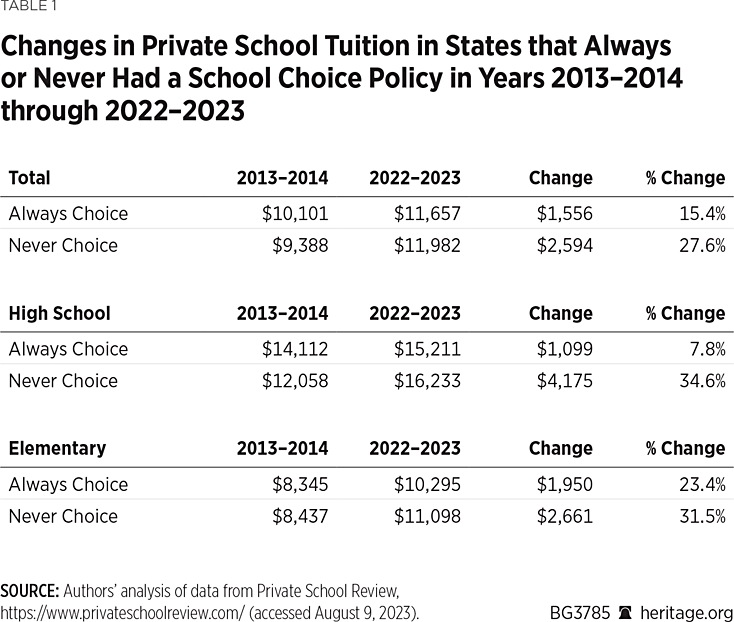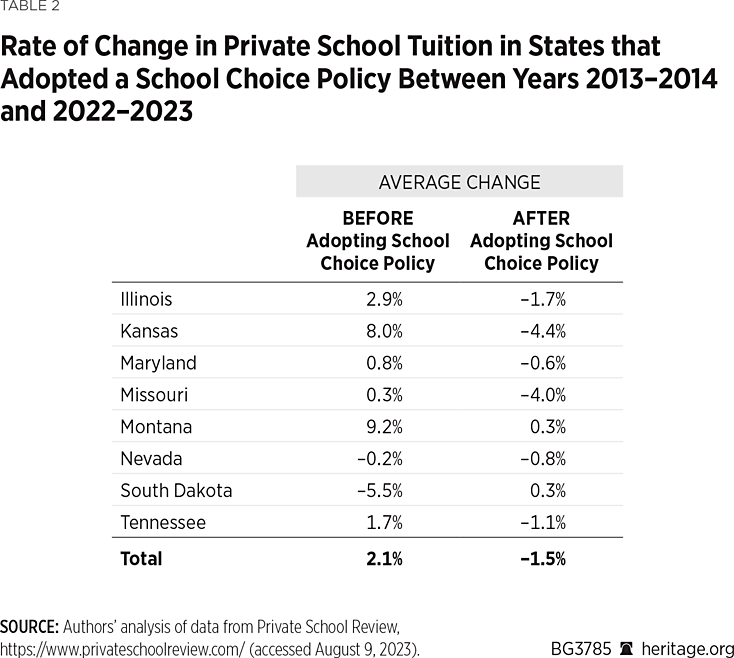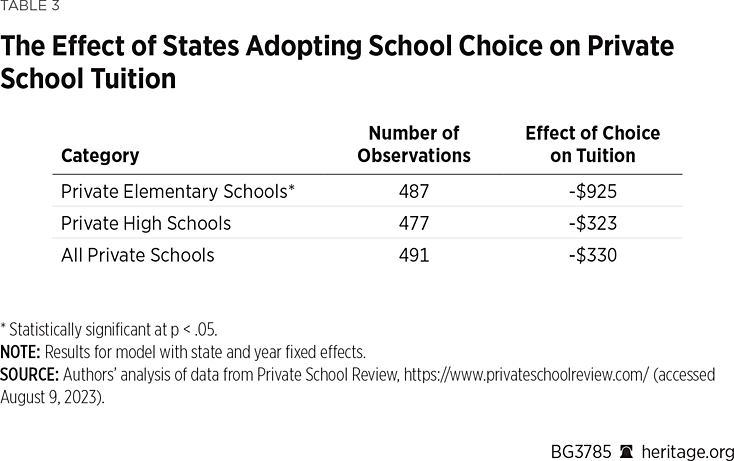In the past three years, more than 20 states have enacted new education choice policies or expanded existing ones. Several more states are considering adopting policies that would allow parents to choose the learning environments that align with their values and work best for their children. However, some critics have raised concerns that school choice policies might spur increases in private school tuition, thereby undermining efforts to expand education options.
The concerns are understandable given America’s experience with higher education subsidies. In 1987, U.S. Secretary of Education William Bennett penned an op-ed arguing that federal subsidies exacerbated college tuition inflation:
If anything, increases in financial aid in recent years have enabled colleges and universities blithely to raise their tuitions, confident that Federal loan subsidies would help cushion the increase. In 1978, subsidies became available to a greatly expanded number of students. In 1980, college tuitions began rising year after year at a rate that exceeded inflation. Federal student aid policies do not cause college price inflation, but there is little doubt that they help make it possible.REF
This theory, which came to be known as the “Bennett hypothesis,” has been largely confirmed.REF A review of the research literature by the Martin Center found that the research “suggests that federal student aid increases university tuition rates, perhaps by as much as 60 cents on the dollar.”REF The effects of these subsidies are evident. As the Martin Center noted in 2017, the “price of college tuition and fees has risen 1,335 percent since 1978: much faster than inflation and faster even than medical care (704 percent) and housing (511 percent).”REF In inflation-adjusted dollars, the national average cost of college tuition and fees has risen 239 percent since 1980.REF
This is Economics 101: Subsidies in a competitive market lead to higher prices. If subsidies fueled tuition inflation in higher education, should one not expect to see the same effects from school choice policies in elementary and secondary education? Education policy commentator Peter Greene has openly wondered why those who are concerned about the Bennett hypothesis in higher education are “not expressing concern about similar inflationary pressures in a school choice ecosystem,” adding that he expects school choice policies “to create an education ecosystem mimicking colleges.”REF
But school choice policies are not being introduced into a free-market education system. Instead, nearly nine of 10 K–12 students attend schools that are entirely subsidized and run by the government. School choice policies introduce competition to a system that is fundamentally uncompetitive. It does not follow, therefore, that subsidies that simultaneously introduce market forces in K–12 education must follow the same pattern as subsidies in higher education. Moreover, recent refinements to school choice delivery mechanisms, namely the advent of education savings accounts (ESAs), provide an additional hedge against inflationary pressures.
Critics of school choice, like Jen Jennings of Princeton University, have pointed to anecdotes from Florida and Iowa, where private schools have raised tuition in the wake of new or expanded school choice policies.REF Jennings claims that these anecdotes show that school choice policies are causing tuition and fee increases more broadly. Likewise, Scott Maxwell, a columnist for the Orlando Sentinel and longtime school choice opponent, predicted that private schools would “jack up their prices now that they know they can bill taxpayers.”REF Or, as Jennings flippantly put it: “Iowa Catholic schools [are] increasing tuition as vouchers roll out. As Jesus famously said, ‘Make it rain.’”REF
Even setting aside the fact that the tuition increases at the Iowa diocese that Jennings cited were part of a “long range plan [that] was put in place several years ago,” long before the enactment of a school choice policy this year, the plural of “anecdote” is not “data.”REF If the critics of school choice are right, then (holding all else equal) states with school choice policies should see higher rates of tuition inflation than states without such policies, and states that adopt school choice policies should see their rates of tuition inflation increase at a faster clip than other states. However, an analysis of the data finds that the reverse is true.
In order to determine the effects of school choice policies on private school tuition, we analyzed 10 years of tuition data from Private School Review.REF The data show that, overall, the adoption of private school choice policies does not elevate tuition rates. If anything, the estimated effect shows that enacting school choice results in private schools charging lower tuitions than they otherwise would, although that effect is not statistically significant.
For elementary schools, however, the introduction of school choice significantly reduces the amount of tuition that private schools charge. For high schools, there is no significant effect of the adoption of school choice on tuition rates. Contrary to the claims made by critics, states that adopt school choice have lowered private elementary school tuition rates and have had no discernable change in private high school tuition rates.
Analysis
Private School Review collects and disseminates the average overall, elementary, and high school tuition charged in each state in each year. Combining that information for the years 2013 to 2022 with information on when private school choice policies were adopted, it is possible to examine the effect of school choice on private school tuition rates. Nine states adopted school choice between 2013 and 2022, while 20 states plus Washington, DC, had previously adopted choice policies, and another 21 states had never adopted private school choice before 2022.
A simple comparison of rates of tuition inflation in states that implemented school choice policies before the 2013–2014 academic year against those that never had school choice before 2022–2023 shows that over the past decade, tuition inflation was higher in states that did not have school choice. As shown in Table 1, states that never had a school choice policy before 2022–2023 (“Never Choice”) saw private school tuition increase by nearly 28 percent, on average. By contrast, states that had adopted school choice before 2013–2014 (“Always Choice”) only saw tuition increase by about 15 percent over the same time period.
The difference was even more pronounced for high school tuition. In states that adopted a school choice policy before 2013 and therefore always had a school choice policy between 2013–2014 and 2022–2023, high school tuition increased by about 8 percent. But in states that never had school choice during that time period, high school tuition increased by about 35 percent—about 27 percentage points higher than the school choice states.

One can also analyze changes within eight states that adopted school choice policies between 2013–2014 and 2022–2023 by comparing the rate of tuition increases, adjusted for inflation, in those states before and after the adoption of choice policies.REF As shown in Table 2, between 2013–2014 and 2022–2023, the average annual change in tuition after adjusting for inflation in states before adopting school choice was 2.1 percent while the average annual change in tuition after adopting school choice was -1.5 percent. In other words, the rate of change in tuition decreased, on average, after the adoption of school choice. In fact, after adopting school choice policies, private schools in those states tended to increase tuition at less than the rate of inflation, which is reducing tuition in real terms.

Although these basic analyses are suggestive, they are not conclusive. The timing of these tuition increases calculated in Table 1 is not aligned with the year when the states adopted or failed to adopt choice policies. Table 2 compares the rate of change in tuition in states that adopted school choice policies before and after adoption but does not compare those changes to the trends in other states. To isolate the causal effect of adopting choice policies on tuition rates one would need to compare the average tuition after choice was adopted to the rate before adoption within the same state and relative to changes in tuition in other states at the same time.
Our model for analyzing the effect of adopting a school choice policy on tuition effectively compares the tuition within states after they adopted choice relative to before they enacted those policies while controlling for how tuition rates change each year in all other states. A more technical way to describe this is that we modeled the average tuition charged in each state in each year with fixed effects for state and year, clustering standard errors by state.
As shown in Table 3, this model estimates that the average tuition for all private schools is $330 less than it would otherwise have been after states adopt a school choice policy, but this effect is not statistically significant. That means that our best guess is that choice reduces private school tuition rates, but we cannot be confident that the effect is really different from zero. Social scientists conservatively and appropriately interpret this as meaning that the adoption of school choice had no discernable effect on tuition.

But when we focus on elementary school tuition, we find that the adoption of school choice policies results in tuition rates that are $925 lower than they would have been had the state not adopted school choice, a statistically significant difference. Given that the average elementary school tuition during the period we examined was $8,128, reducing tuition by $925 represents a large savings for families.
To be clear: This result does not mean that private elementary schools in states that adopted school choice cut their tuitions by $925. It means that they were able to delay or reduce tuition increases so that the amount they charged was $925 less than it would have been given tuition increases occurring in other states that had not adopted school choice during this 10-year period. The savings of $925 is real but it is mostly in the form of reduced tuition increases rather than cuts in tuition rates.
The model also estimates that the adoption of school choice reduced the rate of increase for high school tuition, but that effect is not statistically significant. In other words, the adoption of school choice had no discernable effect on private high school tuition.
What the Results Show
The private school tuition data over the past decade show that school choice significantly reduces elementary school tuition but has no significant effect on high school tuition. If we combine elementary and high school to examine overall tuition rates, we also find no significant effect, suggesting that the introduction of education choice options, such as vouchers, tax-credit scholarships, and ESAs, does not introduce similar inflationary pressures as observed with higher education subsidies. On average, choice policies save money for parents whose children are already enrolled in private elementary school and impose no cost on parents whose children are already enrolled in private high schools. In other words, the competitive market pressures introduced by school choice hedge against any inflationary pressure that may result from parents’ increased purchasing power.
Discussion
Given that people normally associate subsidies with increased prices, it is important to understand why this would not be the case for private school tuition. It is also important to understand why subsidies would reduce tuition increases for elementary schools while having no effect on high school tuition.
The key to understanding these results is to keep in mind that the average private school subsidy in school choice policies almost always exceeds the marginal cost of educating students in private schools. In other words, school choice scholarships tend to be worth more, on average, than the cost to the private school of enrolling one additional child—even where the scholarship values are less than the private schools’ average cost per pupil.
Many private schools have empty seats in classrooms as well as entirely empty classrooms, allowing choice policies to add students without increasing fixed costs for the schools that accept them. If private schools can get the revenue of additional students without incurring a commensurate increase in the cost of additional teachers or buildings, then they can spread their fixed costs across a larger base of students, reducing their average costs per student.
When private schools earn extra revenue in excess of increases in spending, they are in a position to pass along at least some of those cost savings to the parents of their students. To the extent that schools are facing increased competition or are mission-driven to make their schools as affordable as possible, they will be inclined to pass along more of those savings to families in the form of delayed or smaller tuition increases.
For example, in the wake of Florida expanding eligibility for its education choice policies to all K–12 students this year, several Jewish day schools pledged to keep tuition rates affordable, noting that they “recognize the value of affordability” and reaffirming that “their goal is to support families receiving much-needed relief funds toward tuition, while providing a quality education to their students.”REF
When private schools get additional revenue from choice subsidies that exceed their marginal cost of education, it reduces their per pupil cost of education and allows them to pass along savings to families. But why would this happen more with private elementary than private high schools? The reason is that private elementary schools are already cheaper to operate, are more numerous, and have more spare capacity than private high schools. Private elementary schools are more likely to have empty seats and empty classrooms, or can add seats and classrooms at lower cost than private high schools. So, the cost savings of subsidies for private elementary schools tend to be larger, resulting in larger reduction in their cost per student than would be possible for private high schools.
Previous Research
An earlier study, by Daniel Hungerman and Kevin Rinz, examined how eight private-school-subsidy policies in five states affected revenue and enrollment in a limited set of private schools within those states between 1991 and 2009.REF Hungerman and Rinz found that the restricted choice policies—those limited to low-income or students with disabilities—increased private school enrollment and revenue. But the two unrestricted choice policies they examined increased private school revenue without increasing enrollment, meaning that they increased effective tuition rates per student.
While these findings are the only empirical evidence to support the claim that adopting school choice raises tuition rates, there are good reasons to believe that our results are more accurate than the Hungerman–Rinz study. First, the choice policies that they examined between 1991 and 2009 are dramatically different in magnitude than the ones we examine between 2013 and 2022 and the policies that are currently being adopted or considered. Specifically, the average subsidy provided by the policies that Hungerman and Rinz studied was worth $820 in 2012, dramatically less than the subsidies enacted and proposed more recently, which are worth several thousand dollars.REF The average subsidy for the two unrestricted policies they examined was worth only $398. It would be unsurprising if such a modest amount failed to produce a meaningful change in the number of students enrolled in private schools.
Second, Hungerman and Rinz relied on tax filings for their data, but this excluded most religiously affiliated private schools and virtually all Catholic schools from their analyses. They are left with a sample that covers only 20 percent of private school enrollment. Missing the other 80 percent, which included the bulk of the low-cost and mission-driven religiously affiliated private schools, distorts their findings. As explained above, schools with lower costs are more likely to realize greater per pupil savings and those with a stronger mission are more likely to pass along those cost savings in the form of reduced tuition. Focusing on more expensive and less mission-oriented secular private schools is misleading. Our data set, by contrast, covers all private schools.
Third, Hungerman and Rinz base their conclusion about private school subsidies increasing tuition on just two policies that are very different from the design of newer policies that we examine and that are currently under consideration. Specifically, they focus on a tax-credit scholarship policy in Arizona and an individual tax credit policy in Illinois. Neither of these policies resembles the more generous and flexible ESA policies that have recently been adopted or are being proposed.
The Hungerman and Rinz results are especially driven by the Illinois data, though the policy in Illinois provides the smallest benefit and is the least like the ESA policies being implemented of late. When subsidies are large enough to attract new students, private schools can spread their fixed costs over a larger student base and reduce (or at least slow the growth of) their tuition. By contrast, the meager funding in Illinois is unlikely to be sufficient to attract new students to fill empty seats. Without increasing enrollment to reduce their per pupil cost, schools are more likely to capture the subsidy in the form of higher tuition.
Conclusion
Analyzing data from the past decade reveals that tuition inflation was lower in states that adopted school choice policies, on average, than in states that lack school choice. The difference is especially pronounced for high school tuition, which rose by only 8 percent in states with a school choice policy over the last decade compared to 35 percent in states without a school choice policy. Moreover, among states that adopted school choice, inflation-adjusted tuition rates decreased, on average, after the adoption of school choice.
Our more robust statistical analysis of all states over the past decade shows that school choice significantly reduces elementary school tuition and has no significant effect on high school tuition or on tuition inflation overall. On average, choice policies save money for parents whose children are already enrolled in private elementary school and impose no cost on parents whose children are already enrolled in private high school.
Contrary to the claims made by critics, states that have adopted school choice had lower rates of private elementary school tuition increases and no discernable change in private high school tuition rates.
Jason Bedrick is Research Fellow in the Center for Education Policy at The Heritage Foundation. Jay P. Greene, PhD, is Senior Research Fellow in the Center for Education Policy. Lindsey M. Burke, PhD, is Director of the Center for Education Policy and Mark A. Kolokotrones Fellow in Education at The Heritage Foundation.




